First-placed Paris Saint-Germain hosted third-placed Rennes in Ligue 1’s late kick-off this past Saturday evening. PSG came into this game off the back of a midweek UEFA Champions League loss away to Bundesliga side RB Leipzig, while Rennes also suffered defeat in their UEFA Champions League clash with Chelsea last week.
Les Parisiens managed to bounce back from their midweek defeat, however, as they earned a 3-0 win over Rennes in Saturday evening’s game. As second-placed Lille also suffered defeat at the weekend in their meeting with Brest, this win saw PSG extend their lead at the top of the table to five points.
In this tactical analysis piece, we will provide an analysis of both sides’ tactics in this game. For Paris, we’ll examine some of the strengths and weaknesses of their build-up play, how their shape changed over the course of the contest and the key role that their aggressive pressing played in their victor. Meanwhile, for Rennes, we’ll provide some analysis of the various techniques they deployed during their build-up play, the importance of width to their attacking tactics and, similarly to Paris, how they deployed an aggressive press to their advantage.
Lineups and formations
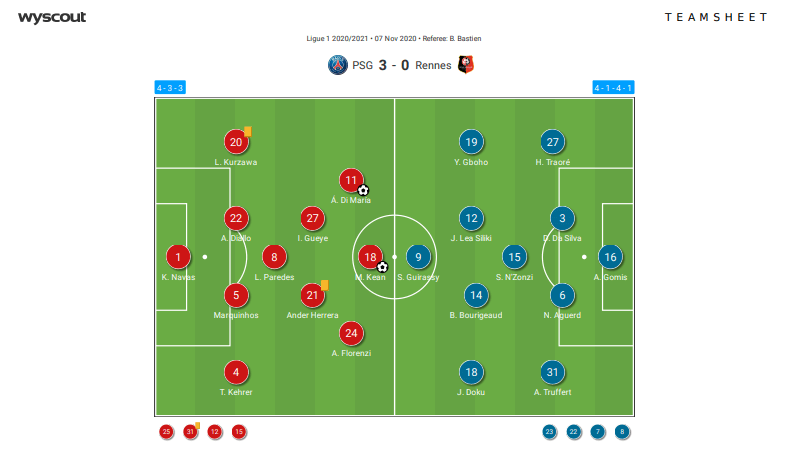
The home side lined up in a 4-3-3 shape for this clash at Le Parc des Princes. Due to how they pressed, which we will discuss in greater length later on in this tactical analysis piece, their shape resembled more of a 4-2-3-1 at times when defending high, while it became a very narrow 4-5-1 when defending deep. On the ball, their shape was more of a 3-2-5, with both full-backs joining the attack and one central midfielder dropping into the backline.
Keylor Navas started in goal for Thomas Tuchel’s side, while right-back Thilo Kehrer, left-back Layvin Kurzawa and centre-backs Marquinhos and Abdou Diallo started just in front of the Costa Rican ‘keeper.
Leandro Paredes played just behind Ander Herrera and Idrissa Gueye in the centre of Les Parisiens’ midfield, while Ángel Di María played on the left side of attack, Alessandro Florenzi played on the right side of attack and Moise Kean played as PSG’s centre forward.
The home side also utilised four substitutes in this game, two of which they were forced to make in the first half due to injury. Rafinha replaced Gueye in the 13th minute and left-back Mitchel Bakker replaced Kehrer in the 36th minute in a change that saw Kurzawa move to the right-back position.
At half-time, Colin Dagba replaced Florenzi in a change that saw Tuchel’s side switch to a back-five with Dagba playing at right wing-back and Kurzawa playing at right centre-back. Lastly, Danilo Pereira replaced Kean – due to another injury – in the 61st minute and he then played at the base of midfield, with PSG switching to a 3-4-3 shape.
As for the visitors, Julien Stéphan’s side played in a 4-1-4-1 but their shape appeared to be more of a 4-3-2-1 without possession for the vast majority of the game due to how they pressed.
Alfred Gomis started in goal for Rennes, while a back-four consisting of right-back Hamari Traore, 18-year-old left-back Adrien Truffert and the centre-back pairing of Nayef Aguerd and Damien Da Silva started just in front of the 27-year-old ‘keeper.
Steven Nzonzi played at the base of midfield just in front of the back-four and he sometimes dropped in between the two centre-backs, while Benjamin Bourigeaud and James Léa Siliki played just in front of him in the centre of Les Rouge et Noir’s central midfield.
Yann Gboho started on Rennes’ right-wing, Jérémy Doku started on Rennes’ left-wing and Serhou Guirassy started up front for the visitors, who also used four substitutes in Saturday’s Ligue 1 fixture.
Gboho and Léa Siliki departed from the pitch in the 56th minute, with Clément Grenier taking Léa Siliki’s spot in midfield and Martin Terrier taking Gboho’s spot in the attack. Bourigeaud was replaced by Adrien Hunou in the 67th minute while Rennes’ last substitution saw Romain Del Castillo take the place of Doku in the 79th minute.
PSG’s tactics off the ball
Now, we’ll provide some analysis of how Tuchel’s side played without the ball in Saturday’s win over Rennes. We will analyse their aggressive press and how they defended deep in this section.
PSG generally press quite high and aggressively and this game was no different. They ended the contest with a PPDA (Opponent passes per defensive action in opponent’s final 60% of the pitch) of 9.8 for the full 90 minutes. This was lower than Rennes’ PPDA of 12.3 for Saturday’s game – which was also quite low, indicating that while both teams pressed aggressively, PSG were slightly more intense in their pressing than Les Rouge et Noir.
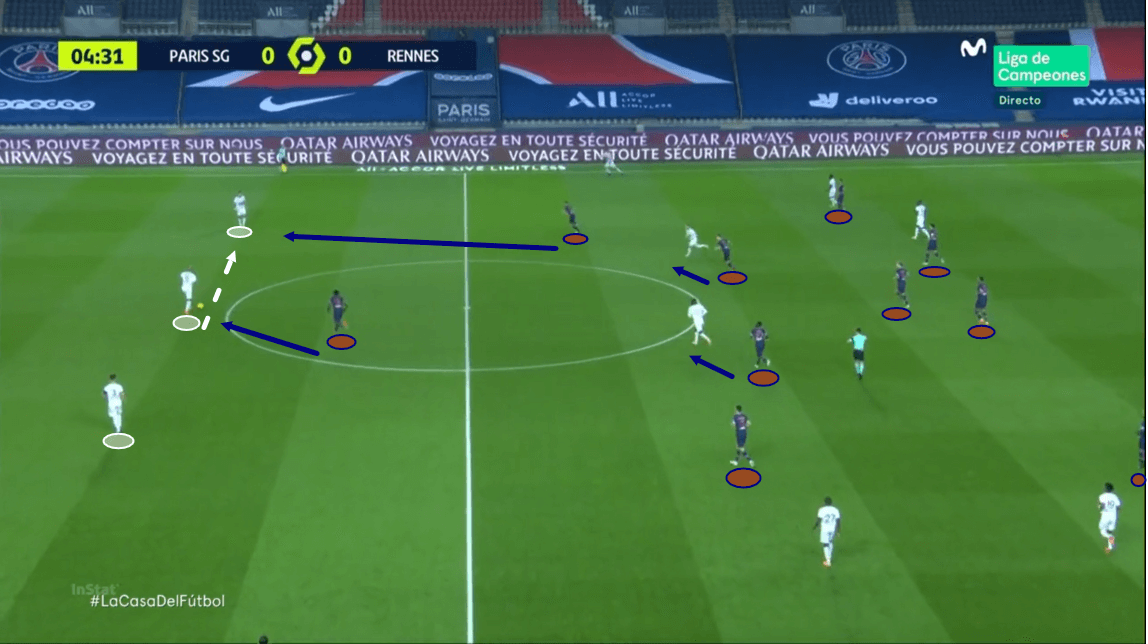
The image below shows us how PSG set up to press Rennes during the build-up. Nzonzi frequently dropped from his holding midfield position to split the centre-backs during this game and we can see PSG sitting in a 4-1-4-1 shape while he is on the ball in the middle of a back-three here, with only Kean applying any pressure to the backline.
As the ball is played from Nzonzi out to left centre-back Aguerd, the home side begins to press more aggressively, as this is the trigger for right-winger Florenzi to spring into action.
Florenzi quickly closes down Aguerd as this pass is played to him, while he also keeps the passing lane between the left centre-back and left-back Truffert in his cover shadow – this was an important part of the PSG wingers’ role off the ball in this game, as when done successfully, it allowed their full-backs to stay back. This took advantage of Rennes’ tendency not to play a lot of long passes, particularly during the build-up.
PSG’s two advanced central midfielders marked Rennes’ more advanced central midfielders very tightly during this game, and with one of Rennes’ central midfielders often dropping deep to provide support in the build-up at times like this, that resulted in PSG’s defensive shape looking more like a 4-2-3-1 but this was due to the strict marking that both of PSG’s central midfielders were tasked with doing.
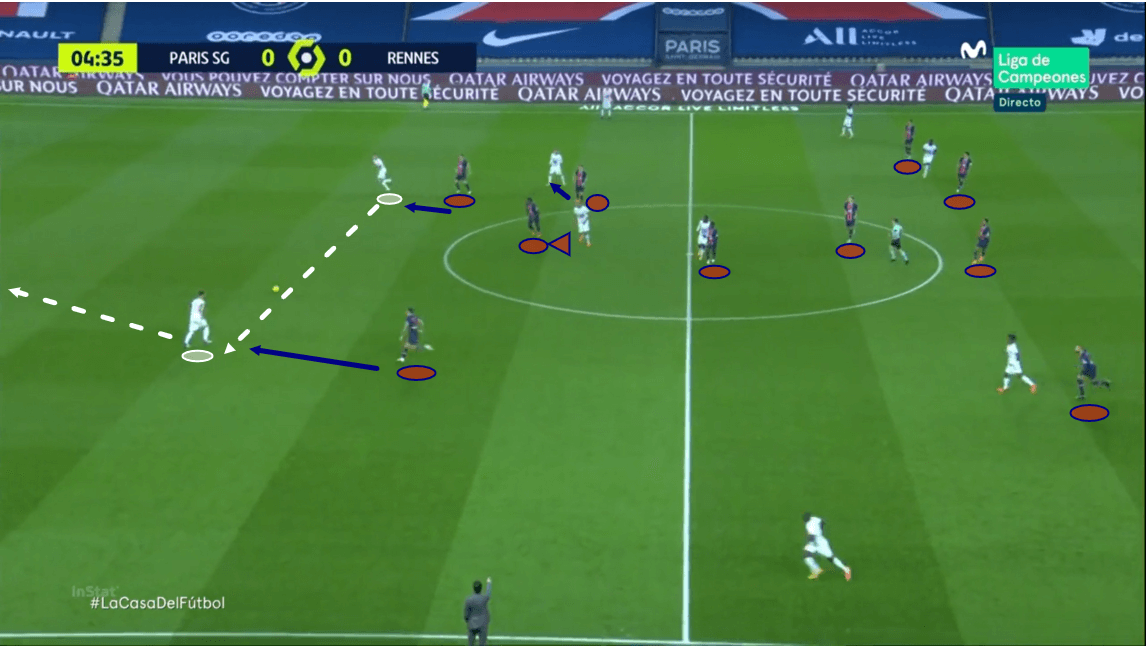
As the play moves on, we can see that Kean stays tight to Nzonzi, Gueye and Herrera stay tight to the Rennes players operating in their corresponding positions and Florenzi closes down Aguerd, preventing him from turning and playing the ball out to the left-back.
This forces Aguerd to play the ball across to right centre-back Da Silva, who attracts pressure from Di María similarly to how Aguerd attracted pressure from Florenzi and this forces Da Silva to play the ball back to the goalkeeper, who then goes long and this allows PSG to win the ball back.
So, we can see from this passage of play how PSG stifled Rennes during the build-up via their pressing in Saturday’s game.
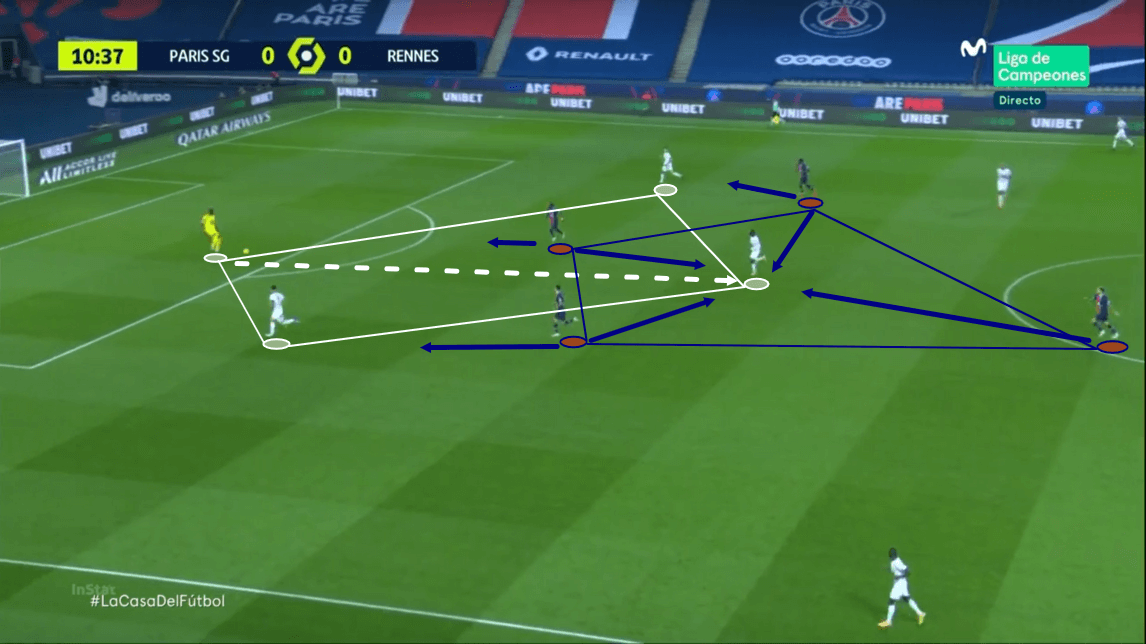
PSG set up central pressing traps throughout this contest. The image above shows us an example of one in the first half which led to Kean scoring the opening goal after a quick recovery high up the pitch.
Just before this image was taken, Rennes were once again forced to play the ball back to the ‘keeper due to Les Parisiens’ press and as Gomis received the ball, Di María began closing in on Da Silva, Kean began closing in on Aguerd, Gueye ended up in a central position as he stuck tight to Léa Siliki so he ends up in the centre forward position closing down the ‘keeper as we can see here and Paredes begins closing in on Léa Siliki in the centre from behind.
As a result of this pressure and as Rennes tried to play out from the back in general in this game, the ‘keeper threads the ball past Gueye and into Léa Siliki, however, as the midfielder receives the pass, he is then enclosed within this box of PSG players that Tuchel’s side intelligently created. None of them stuck tight to Léa Siliki as Gomis received the ball and they opted to leave that passing option open. However, all four men surrounding him were close enough to then spring into action once this pass they allowed to be played, was played.
The box closed in on Léa Siliki as he controlled the ball, he was dispossessed quite quickly and Kean found himself in space to shoot on the edge of the box, scoring and proving how dangerous of a playmaker this type of pressing trap can be when deployed effectively.
Tuchel’s side took advantage of Stéphan’s side’s tendency to play out short from the back here, while they also took advantage of the fact that Léa Siliki found himself in the holding midfield position here instead of the more press-resistant Nzonzi, just as a result of how the game evolved to this point.
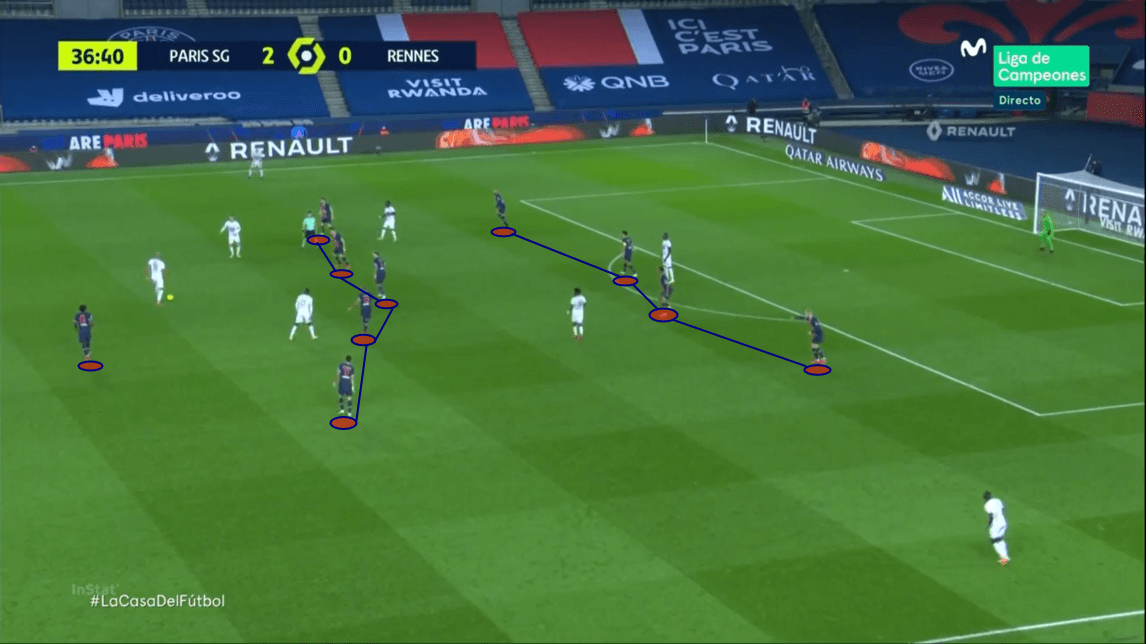
Meanwhile, when defending deep inside their own half, PSG created a 4-5-1 shape, as we can see above. This shape tended to be very horizontally compact, as we can see here. It did allow for some space between the lines which could potentially have been exploited but just due to how narrow their shape was, they made it very difficult for Rennes’ midfielders to play through them.
They left a lot of space open out on the wings for Rennes to exploit by playing in this way and Rennes did make use of this space during the game, creating a lot of chances via the wings.
Les Parisiens shifted from side to side as the ball was played out to the wings and they closed down the wide men in numbers when they received the ball. This meant that Rennes had to up the tempo at some stages when trying to succeed in exploiting this space and they did do that on occasions to exploit this space, despite not typically playing with a very fast tempo.
They were unlucky not to punish PSG for leaving so much space out wide but they did ultimately fail to do so and in the end, it seems as though PSG’s decision to sacrifice this space on the wings was the right one.
Rennes’ tactics off the ball
Stéphan’s side also pressed aggressively and in this section, we’ll provide some analysis of how, exactly, they went about doing that and how they shaped up off the ball.
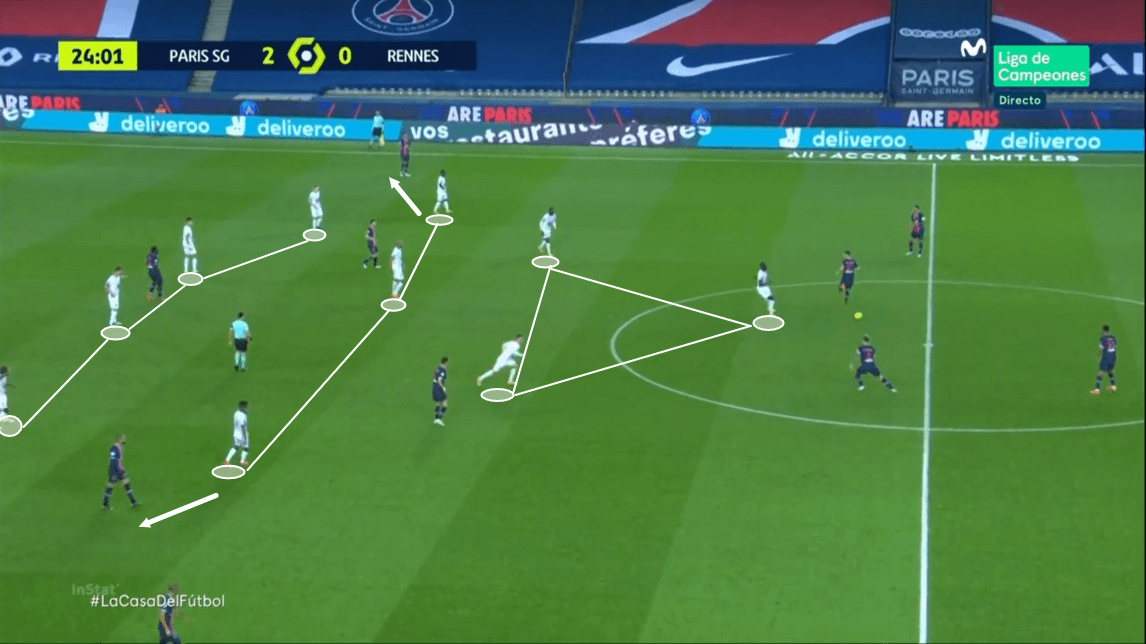
We can see a clear example of the defensive shape that Rennes used for the majority of this game in the image above. The away side used a 4-3-2-1 shape off the ball, with Nzonzi sitting deep alongside the two wide midfielders who tucked inside to essentially form a central midfield three. Meanwhile, Rennes’ two advanced ‘8’s defended slightly higher, either side of Nzonzi and just behind Guirassy.
They utilised this defensive shape when pressing high up the pitch or when defending deeper, which is the case in the image above. This defensive shape provided Rennes with a lot of cover in the centre of midfield, as all five of their midfield players offered some cover in the centre and they helped Les Rouge et Noir to pack this area, making it difficult for Les Parisiens to play through the lines.
Rennes’ wide midfielders also maintained access to PSG’s wide men and if the home side played the ball out wide to them, then Rennes’ wide midfielders would move out wide ahead of the full-backs, allowing them to stay deep and compact with the rest of the defence. This formed a back-five for the away side on these occasions. As this player pressed out wide, he generally kept the pass into the centre in his cover shadow, preventing this from becoming a way for PSG to play the ball into the centre, while Nzonzi would also shift over to provide extra cover to the near central passing option.
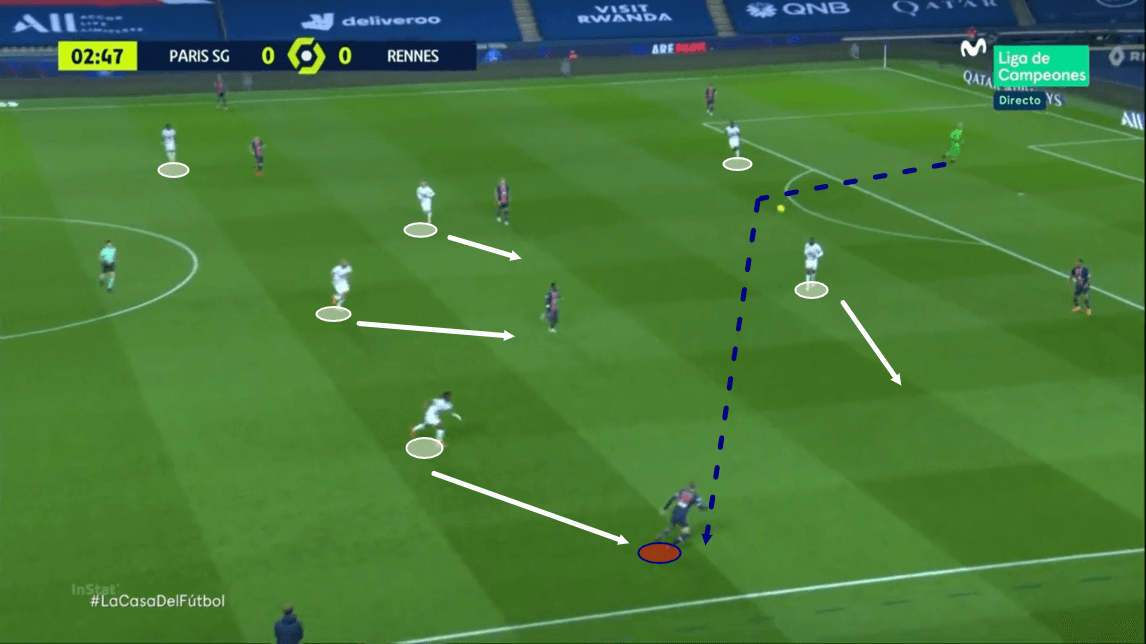
Here, we can see that they maintained this shape while pressing high, though the shape did change slightly just because of how Rennes pressed.
Their press was option-oriented, in that as the ball was played from one PSG player to another, Rennes’ players oriented themselves to cover the nearest potential short-passing options to them for the man on the ball.
The image above provides one example of this. Just before this image, Rennes’ press forced PSG to play the ball all the way back to Navas and he then played the ball long out to left-back Kurzawa.
This pass out wide was the trigger for Gboho to close down Kurzawa and as the ball was being played across, Guirassy moved out to help apply pressure, while maintaining access to both the potential passing option of left centre-back Diallo and left central midfielder Gueye.
Nzonzi also pushed up from his holding midfield position to join in with this high press, getting tight to Gueye. While Nzonzi generally maintained his deep position on the ball in this game, he was part of the midfield three off the ball and joined them in applying pressure high up the pitch, as a result. His focus was not on staying in his zone, as such, it was getting tight to the nearest potential passing option.
Meanwhile, Bourigeaud picked up Paredes as he moved over to try and support his teammate. Bourigeaud’s movement, in particular, was important as Kurzawa did try to find Paredes in the centre while being pressed. This led to Paredes receiving a difficult pass with his back to goal and as he attempted to play the ball upfield, Bourigeaud blocked the ball, forcing PSG deeper.
This shows us how effective Rennes’ press was at actually forcing turnovers high up the pitch. While PSG statistically pressed with more intensity over the course of this game, they didn’t manage to force more turnovers as a result. Rennes made 67 recoveries in this game to PSG’s 60, while Rennes managed to make 34 recoveries in PSG’s half of the pitch and PSG managed to make just 16 recoveries in Rennes’ half. This indicates that Rennes’ press may actually have been more impactful at winning the ball back high, even though PSG’s was effective at stifling their opponents’ build-up.
However, PSG capitalised on the turnovers that they did force more effectively than Rennes did, as two of Les Parisiens’ three goals came after winning the ball back high and Les Rouge et Noir failed to score. This may be more of an indication of the quality of PSG’s attackers to take these chances than anything else, as Rennes did have more shots (14) than PSG (9) and a higher xG (1.24) than PSG (0.65), they just failed to be as clinical as the home side.
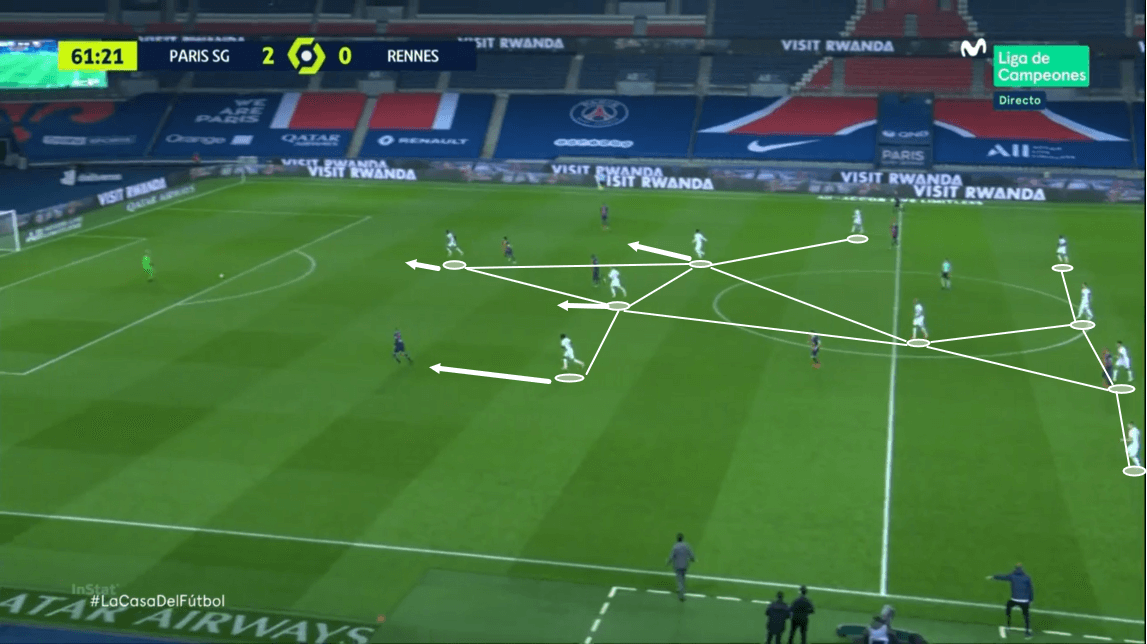
As the game wore on and Rennes continued to trail the home side, Stéphan’s team began to press in more of a 4-1-4-1 shape, giving up some of the protection that they previously had deeper and in the centre to cover more area higher up the pitch during PSG’s build-up after they switched to a back-five.
This may also have represented an attempt to force even more turnovers high up the pitch to create more chances but this throw of the dice didn’t result in goals.
PSG’s tactics on the ball
PSG’s pressing was arguably their greatest offensive asset in Saturday’s win over Rennes as they struggled to create chances on the ball. They ended up taking just nine shots in this game, which is five fewer shots than Rennes managed to take. In this section, we will provide some analysis of PSG’s tactics in possession. We’ll analyse their build-up, their struggles to progress play via the wings and the importance of the movement of their front three in creating gaps in Rennes’ backline.
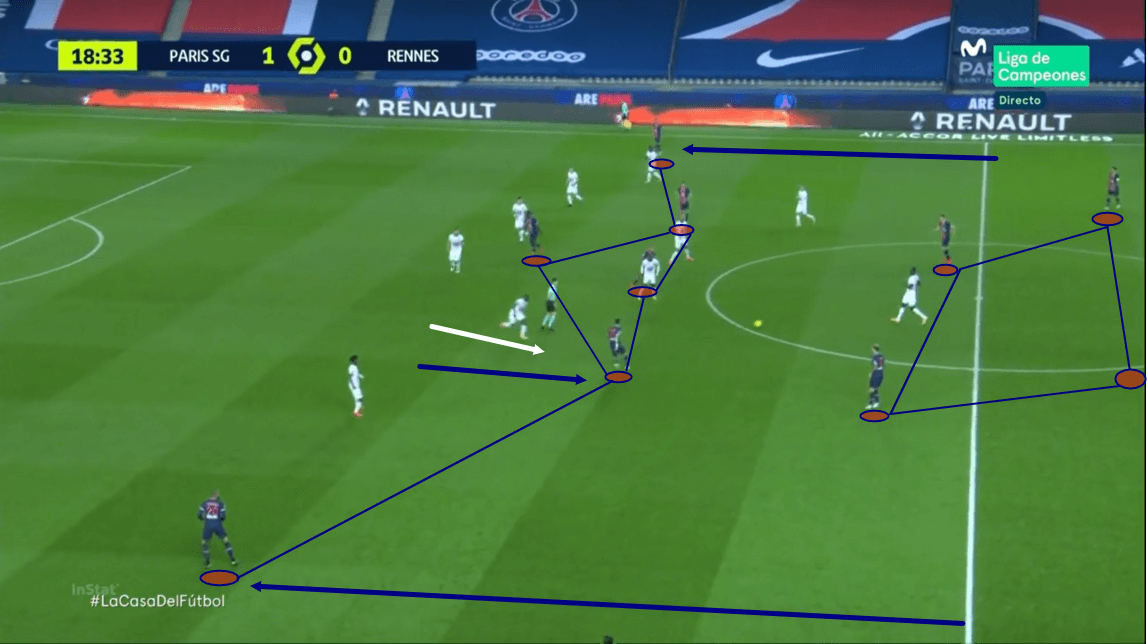
Firstly, this image shows us an example of how PSG’s shape typically looked in possession, during Saturday’s game. We can see that four of their players stayed deep during the build-up – the two centre-backs, Marquinhos and Diallo and two of their central midfielders, in this case, Herrera and Paredes.
Their two full-backs placed themselves high on the wings, providing the width for their side in the attack, while the two wingers, Florenzi and Di María, occupied the half-spaces. Meanwhile, one midfielder, usually Rafinha, played centrally just behind Kean.
In addition to showing us PSG’s offensive shape, this image shows us an example of the importance of the movement of Les Parisiens’ front three during the build-up in helping their side to progress into the final third.
Here, we can see Di María dropping deep to make himself available for a progressive pass from one of the four deeper-positioned PSG players. As well as helping his side to progress the ball high, as the Argentinian winger drops off, he drags one opposition defender out of the backline with him, thus creating a gap that he and his side can potentially exploit. PSG did this on a few occasions during this game and they managed to exploit this space via some quick passing and intelligent movement off the ball.
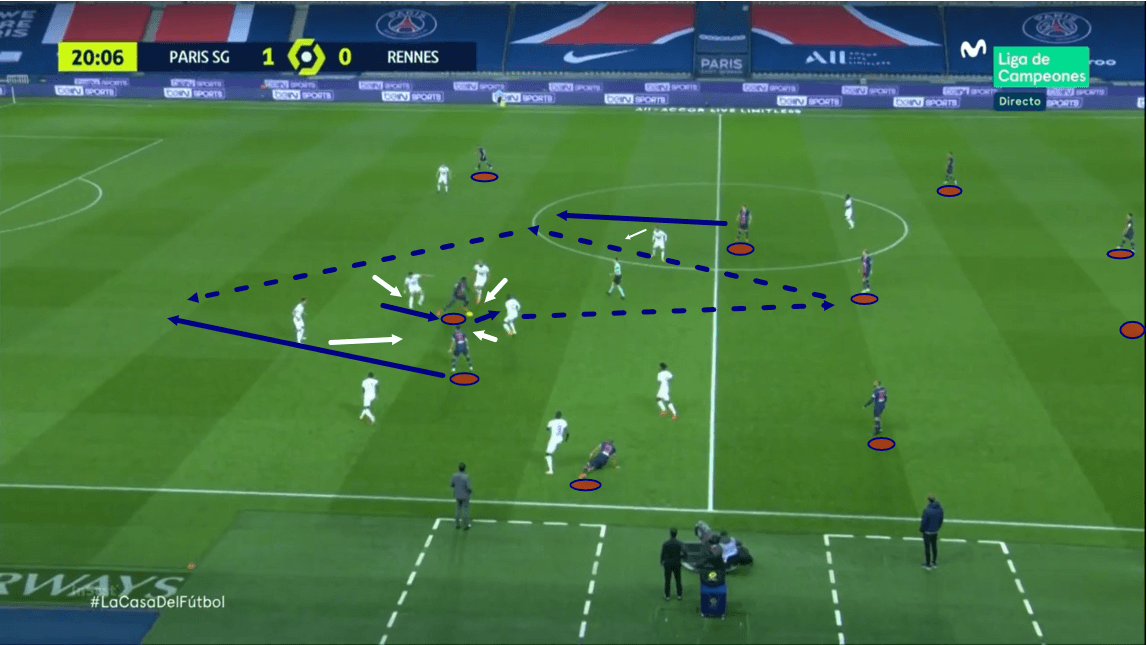
On one of the occasions that they deployed this particular offensive tactic, it led to the second goal of the game. Just before this image above being taken, Kean dropped deep from a more advanced position to the slightly deeper one we can see him occupying in the image above to receive the ball and Rennes managed to find him in space.
He then impressively evaded a couple of challenges to get control of the ball and carry it slightly deeper, attracting pressure and attention from the majority of the opposition in the process.
This created space behind Nzonzi and Bourigeuad in the midfield which Herrera moved into unmarked, while Kean then played the ball back to Paredes who was able to find Herrera in space. Di María then made run in behind the defensive line which Herrera picked out and this played the Argentinian through on goal to score.
This shows us the important role that PSG’s attackers played in building into and creating space inside the final third.
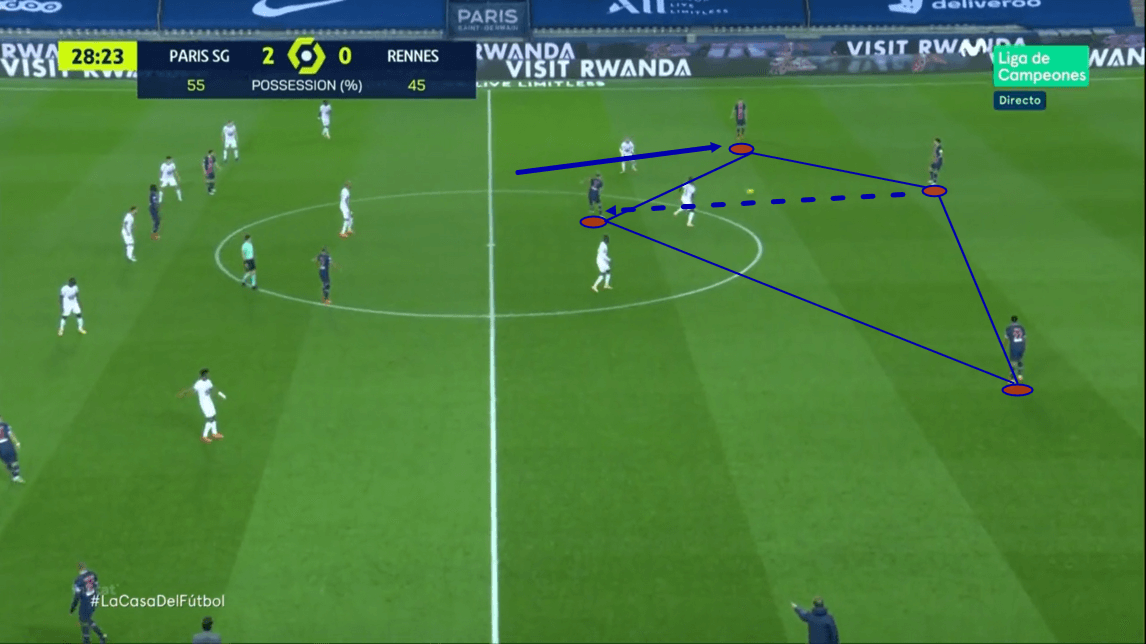
Here, we can see an example of PSG’s typical shape during the build-up. Herrera dropped deep quite often into this position on the right side of defence after the right-back pushed upfield, while Paredes maintained his position in the centre of the park.
The link between these four players was important during the build-up as all four of them boasted some impressive progressive passing numbers, indicating that they were successful in helping their side to progress the play from their own half into the opposition’s half of the pitch.
Paredes, in particular, then played an important role in getting to the next stage, the final third. He played more progressive passes (nine) than any other PSG player in this game, with seven of them reaching their intended target. His intelligent play on and off the ball in the centre of midfield, in terms of how he moved to find space, how well he received possession on the half-turn and went on to accurately find teammates positioned higher up the pitch with his passes, was key for Les Parisiens during the build-up.
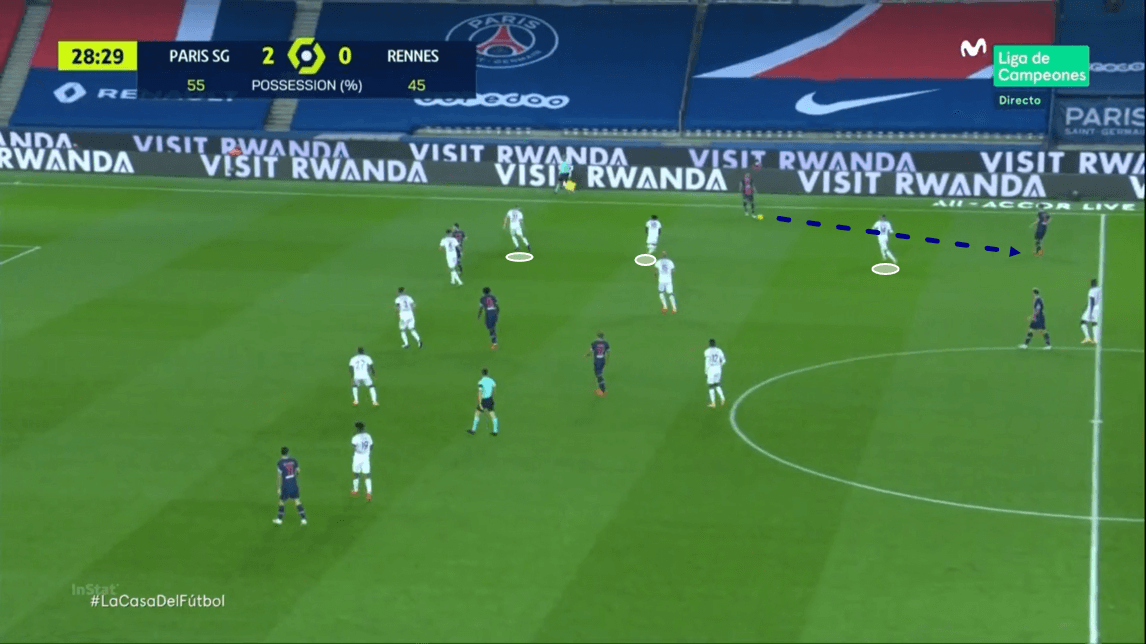
One of the main reasons that PSG failed to create many chances on the ball was due to their struggles on the wings. Kehrer, Kurzawa, Dagba and Bakker all played in one of the two full-back positions for PSG at some stage in this game and as a result, they found themselves providing the width for their side. Meanwhile, Florenzi – who usually plays as a full-back – also found himself out wide on some occasions as he made runs from the half-space to the wing. Di María, on the other hand, tended to stay central.
These five wide players, accumulatively, attempted a total of two dribbles in this game, only one of which was completed successfully. Kurzawa attempted one unsuccessfully and Dagba was the only one of those five to attempt and complete a single dribble in this game.
On top of that, these five wide players, accumulatively, attempted a total of three crosses in this game, none of which were accurate.
In the image above, we can see Kehrer in possession just after receiving the ball out wide. This illustrates an issue PSG’s wide men had throughout this game. They received the ball in this position which wasn’t particularly high. They didn’t make runs in behind the last line of defence from where they could then run in behind and really threaten the defence.
Instead, they received the ball deeper but from here, they usually had at least two Rennes players to beat and the PSG players occupying these positions rarely backed themselves to beat these players on their own. When they did, they generally failed. When they did receive the ball in these positions, the result was often a backwards pass to the player who originally played the ball to them. This led to a significant lack of ball progression down the wings for PSG in this game and an overall lack of chance creation, as these players didn’t get into crossing positions and that is why PSG’s main source of creativity ended up being their pressing and the movement of their front three in central positions.
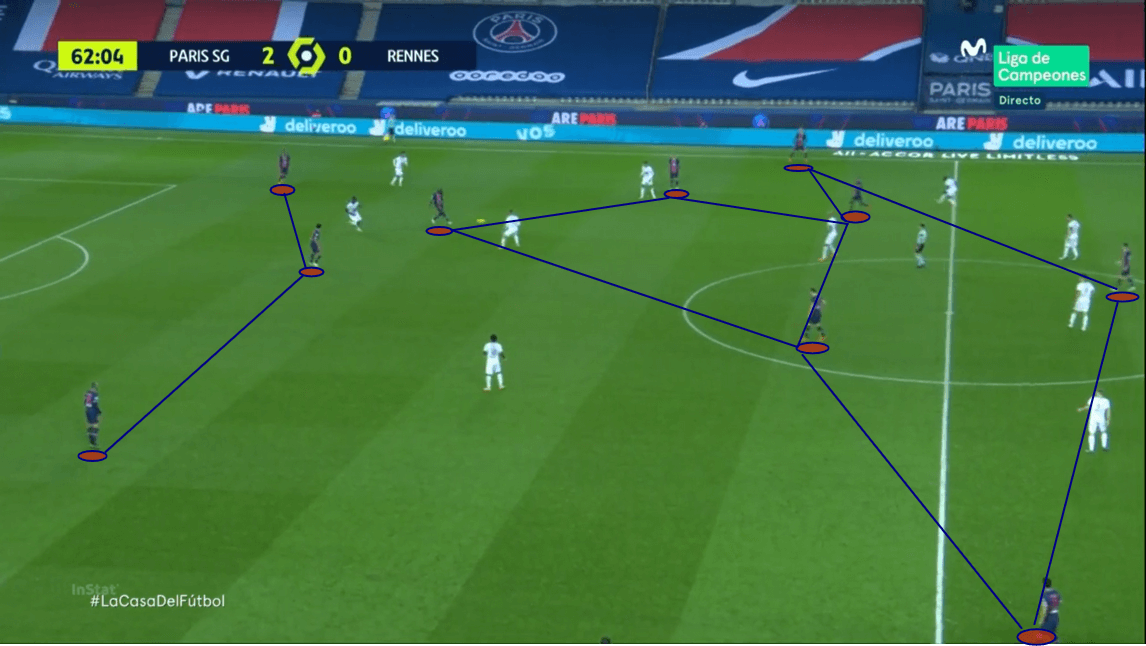
In the second half of this game, PSG switched to a 5-2-1-2 with Dagba replacing Florenzi. Their back-five consisted of right wing-back Dagba, left wing-back Bakker, right centre-back Kurzawa, left centre-back Diallo and central centre-back Marquinhos. When Kean was then replaced by Pereira in the 61st minute, it led to them switching to a Johan Cruyff-esque 3-diamond-3. We can see an example of this shape in the image above.
The back-three remained the same, as did the wing-backs, who positioned themselves high on either side. Pereira formed the base of the diamond, with Herrera and Paredes taking up the central midfield positions either side of him. Rafinha played at the tip of the diamond just behind Di María, who played as a striker. However, this system was quite fluid, especially upfront as Di María didn’t operate as a stationary centre forward and he roamed around the final third, despite being his side’s only striker at this point. This helped him to find space.
PSG had no issues building through the midfield when using this system, as the diamond helped them to overload Rennes in the centre, while Rafinha’s movement also made it difficult for Rennes to defend against him and the image above shows us one example of how he freed himself up in the midfield to receive a pass from Pereira when potential passes to Herrera and Paredes were impossible.
Rennes’ tactics on the ball
Last but not least, we’ll take a look at Rennes’ tactics on the ball in Saturday’s game. This section will provide some analysis of Rennes’ build-up play and we will explain how they utilised the wings much better than PSG.
Rennes had the majority of the possession in this game (52%) and that’s because they typically spent longer on the ball than PSG did. They were more patient in their build-up and tended to play more short passes. This is a big reason why Nzonzi played more accurate passes (72) than any other player in this game.
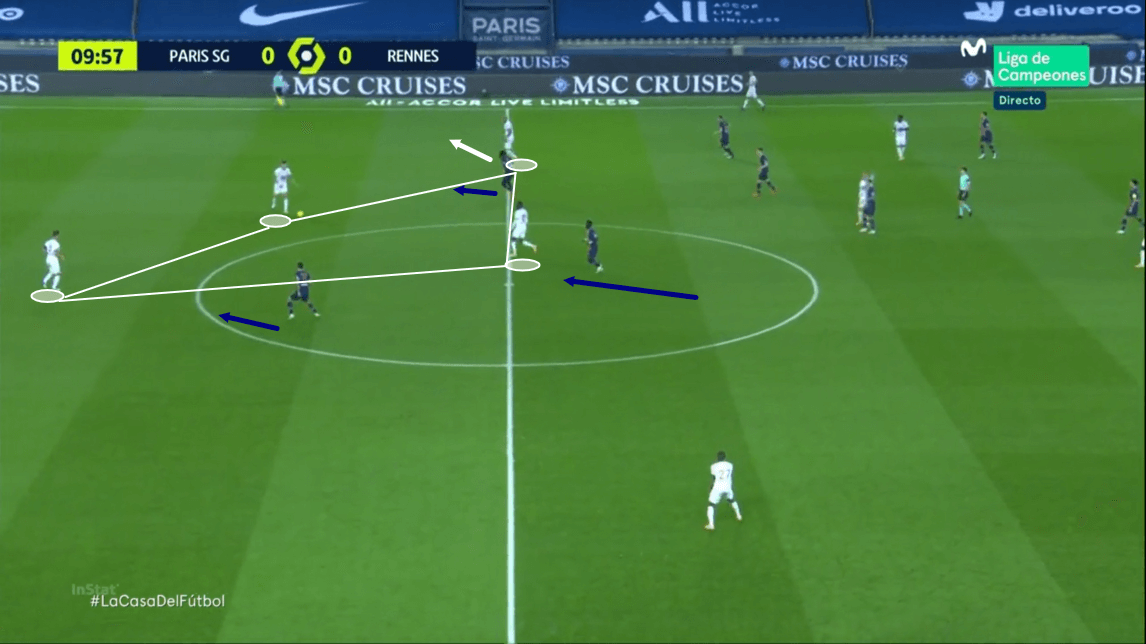
Rennes’ shape during the build-up altered throughout this game. In the image above, we can see one of the shapes that they used in the build-up. Their full-backs always positioned themselves out wide but not extremely high, while their centre-backs naturally always stayed in this position but sometimes they build-up with a double-pivot, with one of Léa Siliki or Bourigeaud dropping deep to join Nzonzi, while other times they build-up with a single-pivot of Nzonzi.
This image shows us an example of the double-pivot, with Léa Siliki dropping deep to occupy the space that has been vacated by Nzonzi after he drifted out to the left-back position to try and drag Kean away from the centre to create space for his teammate to move into freely.
However, PSG’s midfielders tended to stick tight to these midfielders as they dropped deep and this tactic may not have necessarily had the desired impact, as it wasn’t incredibly effective at helping Rennes to slice through PSG’s defensive shape or blow past their effective, aggressive press.
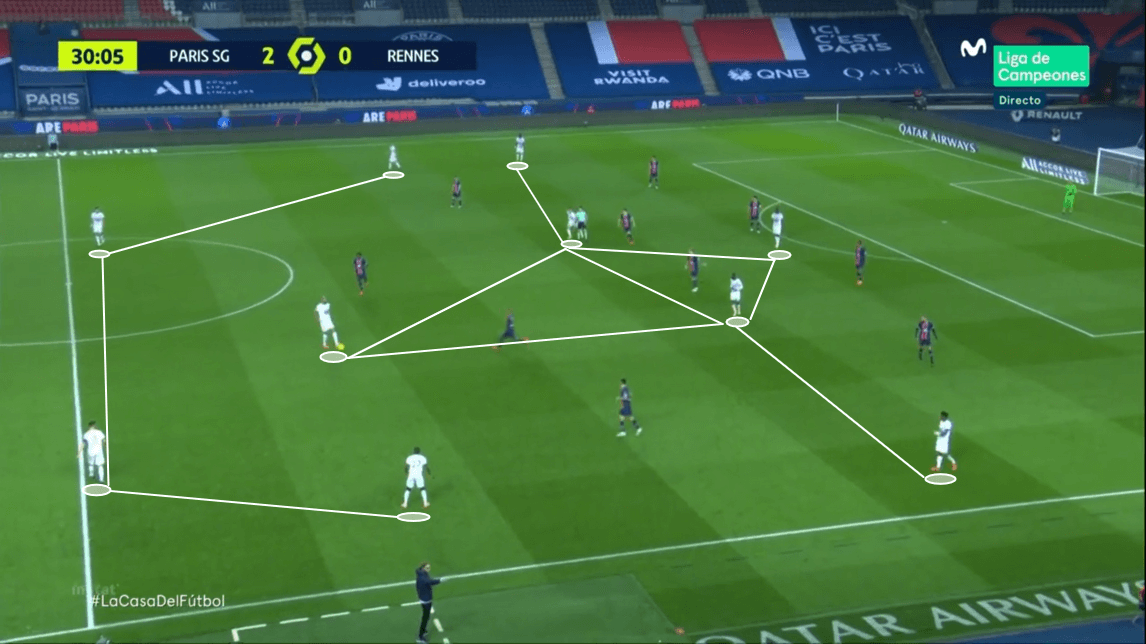
This next image shows us how Rennes shaped up with a single pivot of Nzonzi, which was how they built-up more often than not in this game. As we already mentioned, Nzonzi was heavily involved for the away side as he played more passes than any other player in this game. A lot of Rennes’ play went through him and he was effective at picking up the ball in this type of area and then finding one of his more attacking teammates in a more advanced position, such as the wing or the half-space, similarly to how Paredes operated for PSG.
Both of these images show us how important Nzonzi’s intelligence on and off the ball was for his side during the build-up.
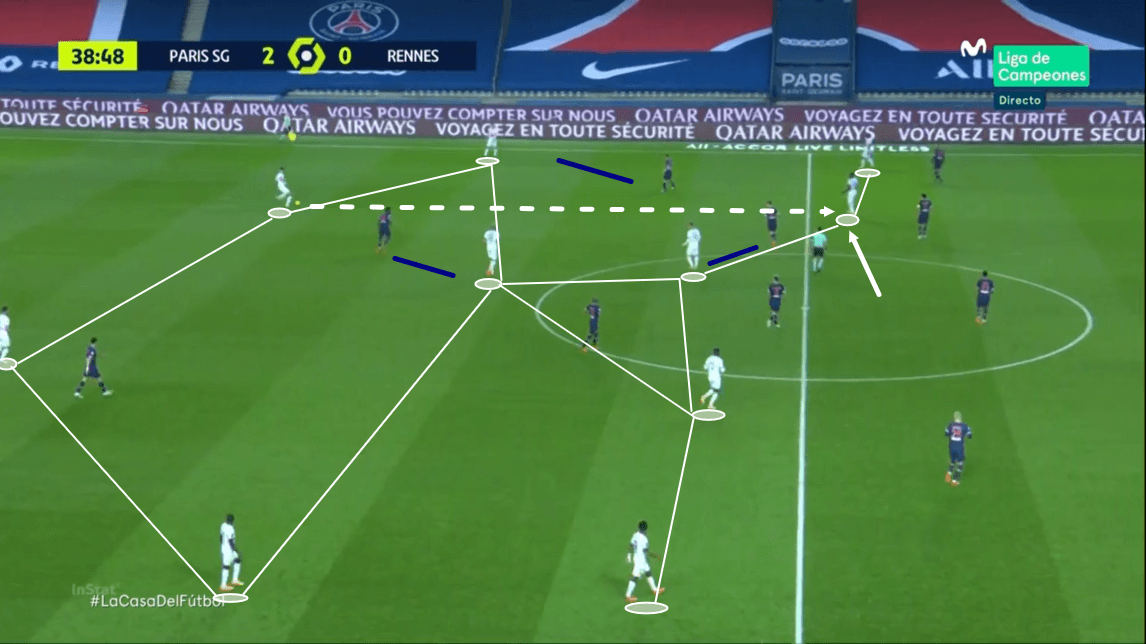
On a few occasions, once trailing in this game, Rennes attempted to build-up more directly. As we can see here, Aguerd can’t find Nzonzi or either of the two more advanced central midfielders as they are all being marked tightly.
Instead, he makes use of centre forward Guirassy who drifted from his natural central position to the right half-space to make himself available for Aguerd, who finds him in this position with a direct pass along the ground.
So, it’s clear that Rennes tried a lot of different tactics in the build-up for this game in an attempt to break down their defensive solid opponents.
Additionally, Rennes used the width of the pitch far better than PSG in this game and the majority of their chances came via the wings. Their greater use of this area may be the key reason why they did create more xG than the home side, though they weren’t clinical enough to take those chances.
Rennes’ starting wingers – Gboho and Doku – along with their starting full-backs – Truffer and Traore – attempted 12 dribbles between them, far more than the two attempted by the aforementioned PSG quintet, eight of which were successful, while they also attempted 14 crosses between them, 10 of which were successful. So, it’s clear that Rennes’ wide men had much more positive influence on their team’s attack than PSG’s wide men did, even though they ultimately came up short.
This was a result of Rennes successfully exploiting the space PSG left free out wide that we mentioned previously and the talent on the ball that PSG’s young teenaged wingers and left-back – as well as 28-year-old Traore – possess.
Rennes’ offensive tactics inside the final third relied heavily on trying to get one of these three players 1v1 against one of PSG’s full-backs, as they had the quality to beat them and create, which they showed on the pitch.
Conclusion
So, to conclude this tactical analysis piece, PSG won this game as a result of their well-organised pressing tactics and the clinical nature of their attackers, though they did have glaring issues during the build-up and when defending deep which they ultimately got away with.
Meanwhile, Rennes deployed some impressive and effective tactics on and off the ball in this one, however, they were unable to capitalise on the chances they created in the end, unlike their opponents, while they paid for their failure to play past PSG’s press in the build-up on a couple of occasions – ultimately leading to their downfall.


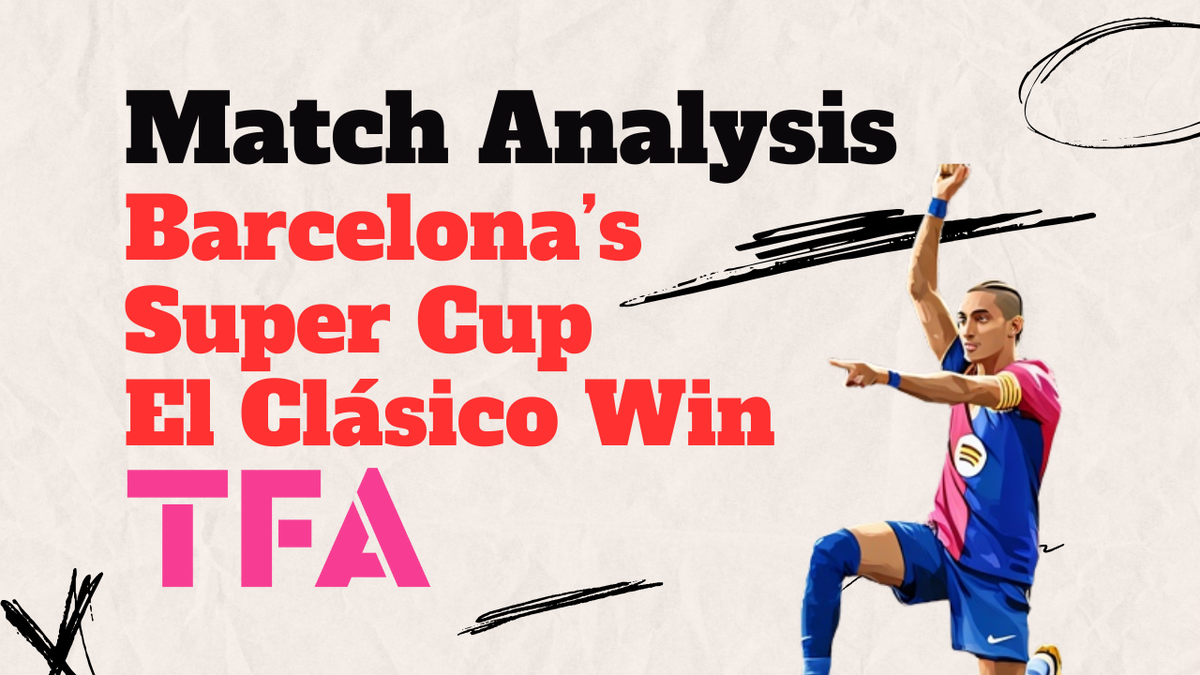
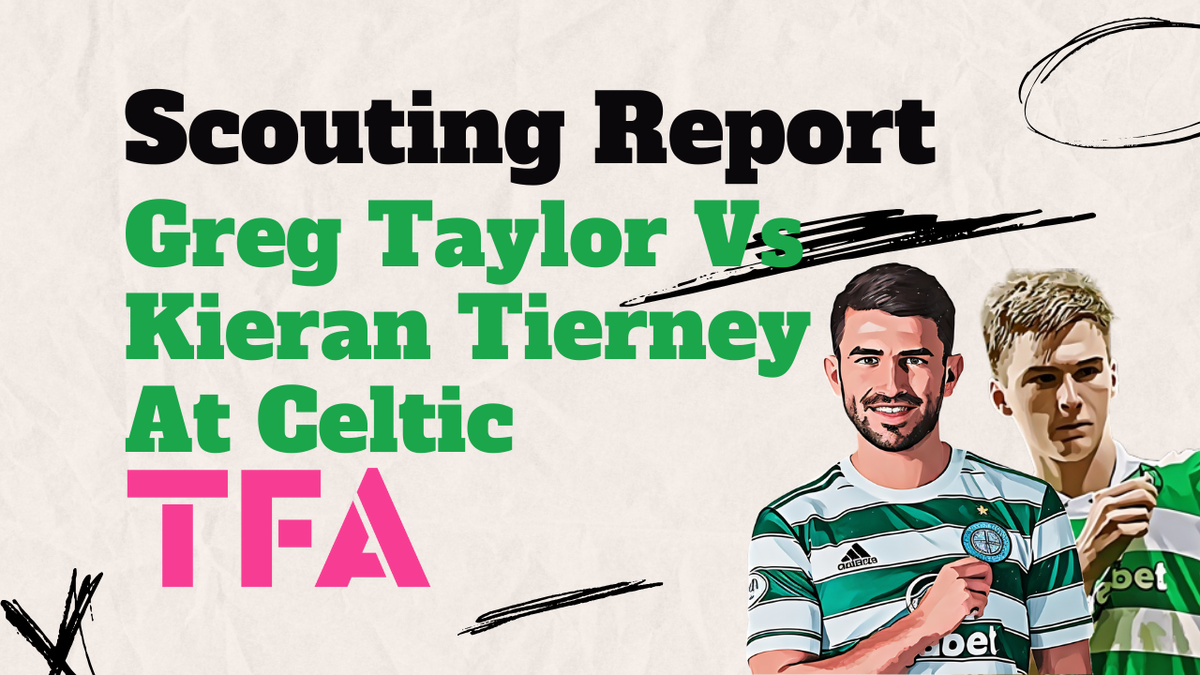
Comments